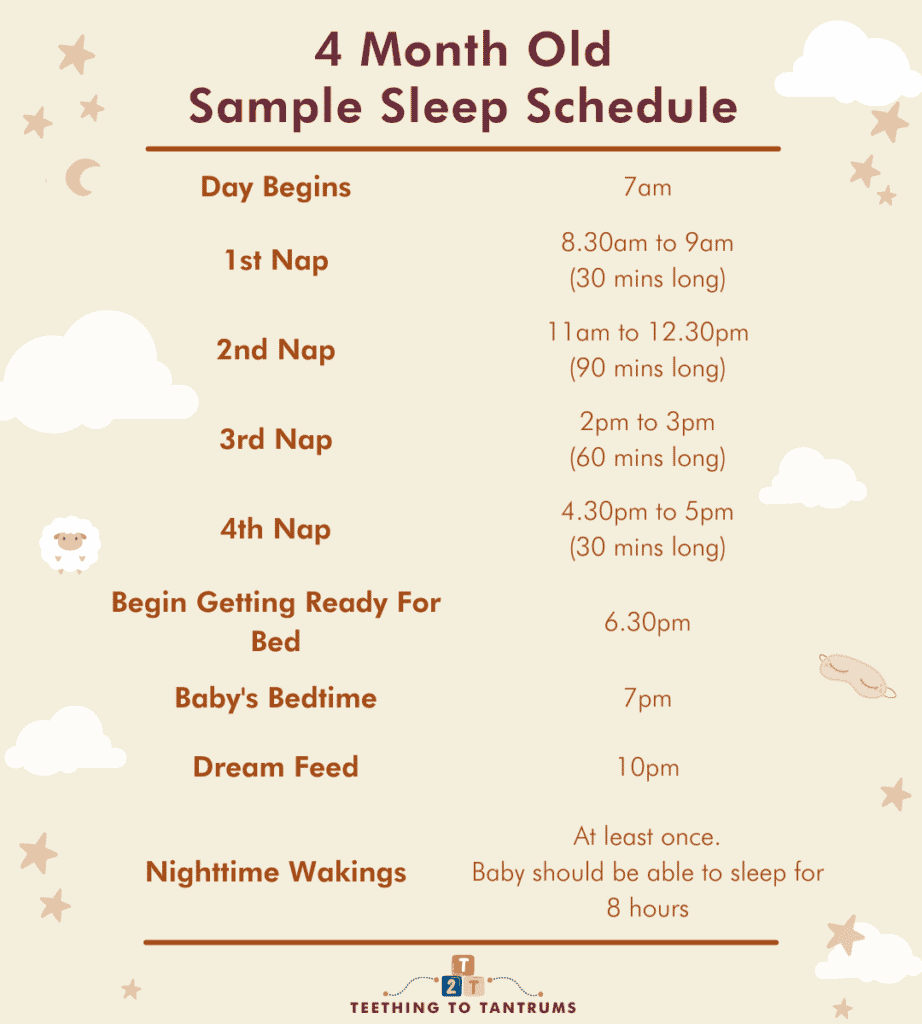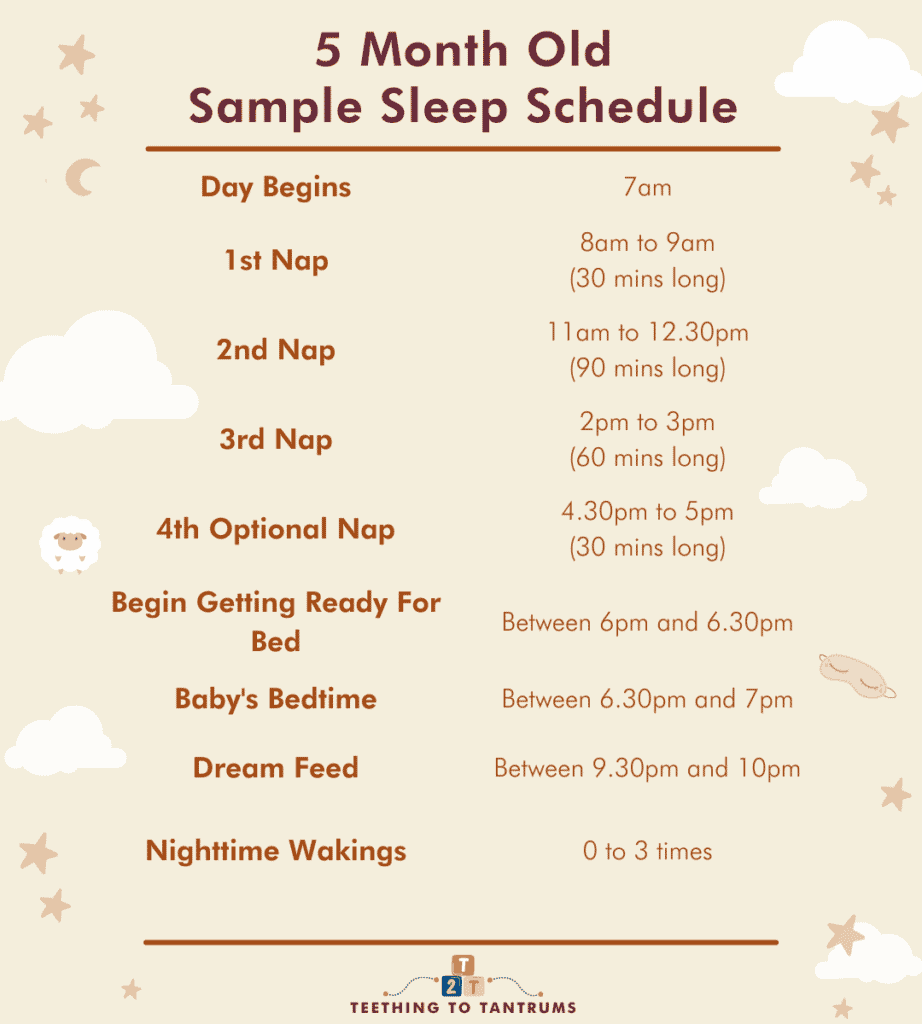Nap transitions can be rough. Learn how to navigate the 4 to 3 nap transition, learn common signs that a nap transition is approaching and how to cope with nap troubles.
What Is The 4 To 3 Nap Transition?
The 4 to 3 nap transition is quite a significant milestone in your little one’s growth. It’s the stage where they start taking fewer naps during the day, to remove the fourth and final daytime nap. This change indicates that your child is ready for a more structured sleep schedule, with three consistent naps throughout the day.
What Age Do Babies Transition From 4 To 3 Naps?
The 4 to 3 nap transition typically happens between 4 to 5 months of age. However, each baby is unique and may transition a bit earlier or later. For this reason, it is essential to pay attention to your baby’s sleep patterns and needs during this time.

Recognising The Signs For Nap Transition
It can be quite daunting for parents to manage the 4 to 3 nap transition. Especially, as you may have finally got your baby into a settled sleep schedule and you obviously want that to continue.
Therefore, it can be challenging to identify when your baby is ready for the 4 to 3 nap transition.
So keeping an eye out for these common signs and sleep cues can help you determine if your little one is ready for this change to ensure you manage the transition smoothly:
- Trouble falling asleep: If your baby has difficulty falling asleep at nap time and/or bedtime, it may be a sign they are ready for fewer naps.
- Morning or early afternoon naps are getting longer. You may start to notice that one of their naps becomes longer than 45 minutes. As a result, fewer naps are now needed each day.
- Waking early from naps or in the morning: Early morning wake-ups or short naps could also suggest that a nap transition is needed.
- Resisting naps: When baby begins to protest or refuse the last nap of the day, it is a good indicator it’s time to readjust their schedule.
- They’re experiencing a 4-month sleep regression: Around the 4-5 month mark, many babies experience a sleep regression that can result in disrupted sleep patterns. This is a typical timeframe for the 4 to 3 nap transition.
- Happy baby despite missing a nap: If your little one can miss a scheduled nap without becoming overly tired or irritable, it may mean they are ready for fewer naps overall.
Balancing these signs with their sleep cues and overall energy levels will help you make an informed decision about your baby’s 4 to 3 nap transition.
NOTE: During this time it’s always important to ensure your baby’s sleep schedule supports their current development while keeping your baby happy and well-rested.
Looking to get your little one to sleep quickly and effortlessly through a healthy nighttime routine? Check out my Bedtime and Nap Cheat Sheet and master the art of making daytime naps and bedtimes as seamless as possible.
A bedtime & nap cheat sheet so good your little one will ask you to put them to bed...
Laura Williams "This is a life saver! I'm so glad I downloaded your bedtime & nap cheat sheet. My little one actually asked me to put him to bed last night! Unbelievable! Thank you so much!"
Click Here For The FREE Cheat Sheet
Which Nap Gets Dropped?
During a 4 to 3 nap transition, it is typically the last nap of the day that is dropped as it merges with baby’s nighttime sleep. This naturally leads to fewer daytime naps and an earlier bedtime.
For example, a 4-nap schedule for a 4 month old might look like this with just 1.5 to 2 hours of awake time before the first nap:

During this transition period, you may notice your baby starts to protest or refuse the last nap. They might have trouble falling asleep at other nap time and/or bedtime, wake shortly after bedtime, or struggle with short naps.
By 5 months their transition sleep schedule should look something like this:

Remember, transitions take time and patience, and every baby is different.
Adjusting The Nap And Sleep Schedule
To facilitate the 4-3 nap transition, try giving your child some flexibility in their nap schedule. Watch your baby’s sleep cues closely as they are a good indicator of when your little one is ready for a nap.
Here are some more top tips to help you adjust your little ones nap and sleep schedule effectively:
Monitor Wake Windows
Wake windows are the periods your baby stays awake between naps. Generally, when your baby is 3 to 4 months old, they have wake windows between 1.25 and 2 hours.
As you transition to a 3-nap schedule, aim to increase their wake windows to 2-2.5 hours.
Observe Your Baby’s Sleep Cues
Pay attention to your baby’s sleep cues as these signs can help you determine if they’re ready for a longer wake period and a reduced number of naps. Common sleep cues include:
- yawning,
- rubbing eyes,
- clenched hands,
- glazed eyes,
- being distracted,
- pulling ears,
- being withdrawn and becoming less social.
Gradually Shift Nap Times
Don’t try to change your baby’s schedule all at once. Slowly adjust each nap time over several days, moving them 15-30 minutes later until you reach the desired schedule.
If your baby still seems to want that last nap but is fighting sleep at bedtime, use it as a brief catnap (approx 30 minutes) to help them get to bedtime without becoming overtired.
You can also try bringing bedtimes forward as a tool to help your baby adjust to the new schedule and dropping the last nap of the day.
Keep Naps Consistent
Once you have established the 3-nap schedule, aim to keep your baby’s naps around the same time each day. This will help them adjust and maintain a consistent sleep routine.
Be Patient
Every baby is different, so some may adjust faster than others. It may take several days or even weeks for your baby to fully adapt to their new schedule.
Remember to be patient and flexible during this transition. You may find that on some days they still need 4 naps and on others 3 depending on what has been happening in their day.
TOP TIP: Don’t be afraid to wake your baby from a nap in order to help them through the transition phase. This is especially fine when it comes to the end of day cat nap.
Frequently Asked Questions About The 4 To 3 Nap Transition
Looking for more information about the 4 to 3 nap transition process? Here are the answers to the most common questions asked by parents just like you.
How Can I Help My Baby Adjust to a 3-Nap Schedule?
To help your baby adjust to a 3-nap schedule, gradually space out their naps and increase the awake time between them. Observe your baby’s sleep cues and put them down for a nap as they show signs of tiredness. Be patient and consistent in your approach, as it may take some time for your baby to adapt to the new schedule.
What Is the Hardest Stage in Nap Transitions?
The hardest stage in nap transitions varies for each baby, as they all develop differently. However, the transition from 2 to 1 nap can often be challenging, as it requires a longer awake period and balancing an appropriate bedtime. Focus on understanding your baby’s sleep needs and adjusting their routine accordingly.
Is It Normal for a 6-Month-Old to Still Have 4 Naps?
While most babies drop to 3 naps by 4 to 6 months of age, some may still have 4 naps at six months. Each baby is different, and their sleep needs may vary.
If your 6-month-old is still taking 4 naps but sleeps well at night and is meeting their developmental milestones, it’s generally not a cause for concern. Consult with your pediatrician if you continue to have concerns about your baby’s sleep.
How Long Does It Usually Take for a Baby to Adjust to the 4 to 3 Nap Transition?
The time required for a baby to adjust to the 4 to 3 nap transition can vary from a few days to a couple of weeks. It largely depends on your baby’s individual sleep needs and how effectively you implement the new schedule. Be patient and consistent in your approach, and communicate any concerns you have with your pediatrician if needed, to put your mind at rest.
Need More Parenting Help?
- Download our FREE Bedtime & Nap Sleep Cheat Sheet. It’s a free, easy-to-use and proven formula designed for parents of 0-5 year olds to master the art of consistently undisturbed and restful sleep without the yelling, nagging or exhausting long-winded evenings.
- Check out our Parenting Toolbox. You’ll get access to expertly-chosen products that you can guarantee are the best for your little one and your wallet.
- Are you looking for personalized guidance to navigate the challenges of parenting? I offer 1-on-1 consultations to bring you tailored strategies and actionable advice to help support your child's growth and well-being with confidence.

A bedtime & nap cheat sheet so good your little one will ask you to put them to bed...
Laura Williams "This is a life saver! I'm so glad I downloaded your bedtime & nap cheat sheet. My little one actually asked me to put him to bed last night! Unbelievable! Thank you so much!"
Click Here For The FREE Cheat Sheet


